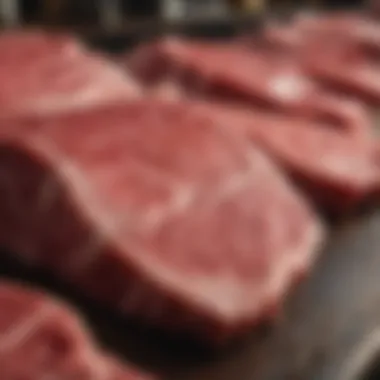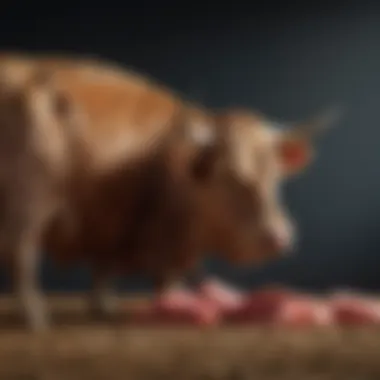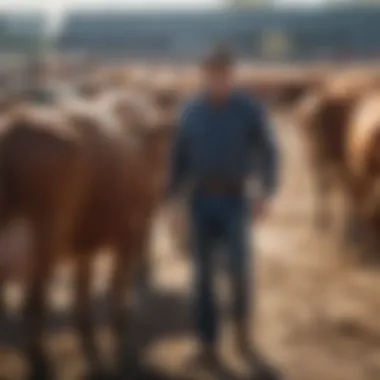Understanding Beef Prices on the Hoof: Key Insights


Intro
The price of beef on the hoof – that's the kind of phrase that can get both seasoned farmers and casual enthusiasts scratching their heads. Understanding these prices is not just about keeping tabs on market swings or knowing when to buy or sell. It's about grappling with the multifaceted dynamics that underpin livestock economics. As the world leans more towards sustainable practices and local sourcing, the significance of grasping these price movements escalates.
In this article, we are diving into the intricate web of factors that shape the cost of beef at the farm gate. We'll examine the terminology that’s fundamental to this field, look at the latest trends and innovations influencing the market, and map out practical applications for those in the agricultural scene. Whether you're a cattle producer looking to maximize your profit margins or just someone curious about where your steak comes from, there's something here for you.
Key Concepts and Terminology
Definition of Terms
To kick things off, let's unravel some essential vocabulary that serves as the backbone of this discussion:
- Beef on the Hoof: This refers to live cattle, as opposed to beef that has already been processed. It's a commonly-used term in the farming community.
- Market Price: The price at which cattle are bought and sold. This can fluctuate based on various influences, like supply and demand.
- Grade and Yield: These terms often define the quality of the beef produced. The USDA grading system, which ranges from Prime to Canner, plays a crucial role in determining pricing.
- Supply Chain: This encompasses everything from ranch operations to the point of sale, including logistics and processing plants.
Overview of Relevant Practices
Navigating the price of beef on the hoof requires an understanding of relevant farming and market practices. Here are some points to ponder:
- Animal Husbandry: Effective breeding and feeding practices can significantly impact the quality and weight gain of cattle, ultimately influencing market prices.
- Seasonal Trends: Price fluctuations occur throughout the year, often peaking during certain holidays when demand is high.
- Global Influences: Trade policies, foreign market demands, and climate conditions are just a few international factors that can create ripples in local pricing.
"Understanding the terminology and practices in beef production is essential for any stakeholder aiming to operate efficiently within the market."
Current Trends and Innovations
Latest Research and Developments
New research surfaces regularly in agricultural studies, highlighting novel insights into beef production. Trends towards regenerative agriculture and beef raised with lower carbon footprints are gradually gaining traction. Moreover, understanding how nutrition affects growth rates is an active research frontier.
Emerging Technologies and Tools
In the digital age, farmers are not left behind. Precision farming technologies are slowly becoming the norm. Here are a few tools that are changing how beef producers operate:
- Blockchain Technology: This helps in tracking meat from farm to fork, improving transparency.
- Drones and Satellite Imaging: Used for monitoring crop health and livestock behavior, making operations more efficient.
- Mobile Apps: These tools can assist farmers in tracking market prices and managing livestock more effectively.
Practical Applications
Step-by-Step Guides
For farmers looking to navigate the changing landscape, a practical approach can be beneficial. Here’s a simple guide to following price trends:
- Stay Informed: Regularly check agricultural journals and websites to remain aware of changing market conditions.
- Calculate Costs: Always keep detailed records of feed, vet care, and operational expenses. This allows for precise assessments of profit margins.
- Network: Engage with other farmers and industry professionals to exchange insights and strategies.
Troubleshooting Common Issues
In this line of work, problems are bound to arise. Farmers often face challenges like fluctuating feed costs or sudden market drops. Some approaches to address these issues include:
- Diversification: Exploring alternative revenue streams, such as selling to local markets or direct-to-consumer sales.
- Risk Management: Implementing basic hedging strategies can protect against unforeseen dips in prices.
Market Overview of Beef Pricing
The landscape of beef pricing encompasses a wide range of factors, offering a detailed view into the economic intricacies of the livestock industry. Understanding this market is crucial not just for producers but for consumers, traders, and even policymakers who aim to navigate the complexities of agricultural economics. The price of beef on the hoof, which refers to cattle sold before being processed, serves as a significant indicator of overall market health.
Defining Price of Beef on the Hoof


The price of beef on the hoof fundamentally reflects the value of live cattle in the marketplace. This price isn’t merely a number on a receipt; it encapsulates countless variables, such as the livestock's health, breed, age, and the prevailing demand in the market. In essence, this price is a direct link between producers and consumers. For example, prices can fluctuate based on how many cattle are being sold at any given time—a principle rooted in classic supply and demand economics.
Additionally, understanding how this price is defined helps stakeholders make informed decisions about breeding, feeding, and sale timing, which drastically affect profitability. As certain breeds like Angus or Hereford may command higher prices due to their reputation for quality, being aware of these nuances is vital for farmers trying to optimize returns.
History of Beef Pricing
Delving into the history of beef pricing reveals a rich tapestry that involves both economic adjustments and cultural shifts. Historically, the price of beef has mirrored various economic climates—booms in demand during prosperous times lead to soaring prices, while recessions often bring the opposite effect.
To give context, in the early 20th century, cattle ranching was an integral part of America’s growth, yet prices fluctuated wildly due to World Wars and economic turmoil. The establishment of the Chicago Mercantile Exchange in the 1970s brought a formalized market structure, allowing producers to hedge against risks and stabilize income—hence contributing to a more predictable pricing structure. This historical lens paints a broader picture and provides insight into the cyclical nature of beef pricing, reinforcing that the past holds lessons for today’s market conditions.
Current Market Trends
In today’s world, the beef market is influenced by a myriad of factors, from consumer preferences for organic products to global supply chain disruptions. Recent trends show a notable increase in demand for grass-fed beef, with consumers becoming increasingly conscious of sustainability. This shift impacts pricing as producers adapt to meet these demands, often leading to higher prices for beef that adheres to these quality standards.
Furthermore, the ever-changing landscape of international trade affects the dynamics of beef pricing significantly. Countries are increasingly trading beef, with negotiations that can swing pricing based on tariffs, quotas, and import/export regulations. These market trends emphasize the importance of adaptability for livestock producers and underline the need for a strategic approach to pricing in light of both local and global influences.
"To navigate the unpredictable currents of beef pricing, one must be not just a producer but a keen observer of market trends and economic indicators."
Factors Influencing Pricing
Supply and Demand Dynamics
At the heart of pricing are the principles of supply and demand. When there’s a favorable season for grazing, abundant feed, and good weather, supply tends to rise. Farmers are more willing to raise larger herds, leading to a potential drop in prices. Conversely, if the market faces a drought or disease outbreak, the supply can tighten like a noose, causing prices to soar. Just think of how when everyone wants a piece of pie, the price goes up, but if no one wants it, leftovers are practically given away.
In rural America especially, this push and pull is evident. Cattle markets can swing drastically based on seasonal trends and shifts in consumer preferences. For example, if beef cuts suddenly gain popularity in trendy restaurants, demand can spike, and that affects the amount sellers are willing to part with, thus increasing the price. The supply and demand dynamics form the backbone of the beef pricing puzzle.
Feed Costs and Production Expenses
Now, let’s dive deeper into the nitty-gritty with feed costs, which represent a significant slice of a rancher's budget. Good farmers keep an eye on the cattle feed market as it often fluctuates just like weather patterns—sometimes erratic and unpredictable. When corn or soy prices rise, as they have in recent years, farmers feel the pinch. Rising feed costs put pressure on ranchers to maintain profit margins.
Morevoer, production expenses include veterinary services, labor, and equipment costs. A sharp an increase in these costs can prompt ranchers to either pass these costs onto consumers through higher prices or face tighter margins. Either way, it creates a ripple effect through the beef pricing model, affecting more than just ranchers. The details here matter greatly because even small shifts in costs can displace the entire market.
Health and Quality of Livestock
Livestock health is another crucial factor that can’t be ignored. A healthy herd is often a productive one. If herds are inspected regularly and managed well, buyers generally will pay a premium. The reputation of a ranch hinges on the quality of its livestock—think of it as a brand in the marketplace. If a ranch earns a name for raising high-quality beef, the initial price on the hoof reflects that.
The methods of breeding and feeding play a significant role here. Grass-fed beef might fetch higher prices than grain-fed, largely due to perceived health benefits and flavor profile. However, if disease strikes, the quality of livestock can plummet, and prices can tumble faster than you can say “sick cow.” This aspect ties back into the consumers, who are increasingly becoming conscious of sourcing and quality in their food choices.
As we navigate the waters of beef on the hoof pricing, it is clear that understanding these nuances is essential for anyone involved in the beef industry. The delicate interplay of supply, expenses, and the health of livestock ensures that beef pricing remains a multifaceted subject ripe for discussion.
Economic Implications
When we consider the impact on producers, it's clear that beef prices directly influence the financial viability of cattle ranching. High prices can encourage increased production, as farmers look to capitalize on better margins. Conversely, a steep decline in prices can spell disaster for many, leading to difficult decisions about herd sizes and even market exit. Producers often need to assess their cost structures, input expenses, and ultimately their selling prices to ensure sustainability in such a volatile market.
"Understanding pricing dynamics is critical for producers if they are to remain competitive and profitable in a fluctuating environment."
Examining consumer behavior and price sensitivity reveals fascinating insights into market dynamics as well. Price changes can significantly affect buying habits, with consumers often opting for less expensive cuts of beef or alternative proteins during tough economic times. Those shifts in consumer preference demand that producers and retailers stay agile, adjusting their offerings to meet market demands. It highlights how beef pricing isn't just about dollars and cents; it’s about understanding the pulse of consumer sentiment and willingness to pay.
Lastly, the global markets and trade relations component cannot be ignored. The beef industry operates within a global framework, subject to varying trade agreements, tariffs, and international regulations. For instance, beef exports can be influenced by domestic pricing. If beef goes for a song on the domestic market, exports might take a hit as overseas buyers find better deals elsewhere. In contrast, favorable trade relations can lead to greater demand for beef, thus exerting upward pressure on prices. In this interconnected landscape, shifts in one part of the world can echo through the beef supply chain, affecting producers and consumers alike.
The intertwining elements of pricing in the beef market not only reflect agricultural economics but also help shape it. Recognizing these implications helps stakeholders position themselves better in the market, ultimately contributing to a more stable and competitive industry.
Regional Price Variations


Regional price variations are a critical aspect in understanding the economics of beef prices on the hoof. Regional factors can affect market dynamics significantly, resulting in prices that may differ widely from one locale to another. This variance is not merely a footnote; it’s pivotal in guiding decisions made by farmers, investors, and consumers alike. Failing to grasp these nuances can lead to poor purchasing choices and investment missteps.
Understanding Local Markets
Local markets act like a delicate ecosystem where numerous variables interplay. Each region has its unique buyer preferences, livestock breeds that thrive better in local climates, and distinct transportation costs. Farmers in Texas, for instance, might focus on raising Angus cattle due to its favorable meat quality, while farmers in the Midwest prioritize Hereford for its adaptability to the colder climate. Having a good pulse on local consumer behavior often shapes pricing strategies too. Local festivals and farmers' markets, where consumers have direct access to producers, can inflate the prices due to higher perceived value and quality.
- Key factors to consider include:
- The prevalent livestock breeds
- Seasonal festivals and community events
- Proximity to processing facilities
This regional flavor can shift how beef is valued, emphasizing the importance of localized pricing insights.
Effects of Climate and Geography
The symbiotic relationship between geography and climate directly impacts beef pricing on the hoof. Regions prone to extreme weather patterns, like drought or floods, can see significant cost fluctuations. Drought in the Southwest can lead to higher feed prices when livestock is dependent on pastureland that shrinks in those conditions. On the flip side, regions benefitting from abundant rainfall might enjoy lower feed costs, thus slanting their prices favorably.
Geographical elements affect product quality too. Meaty cattle raised in grass-fed pastures in the lush Midwest generally command higher market values compared to those raised in arid regions where livestock may not achieve optimal growth.
The effects of climate on pricing aren’t just seasonal; they create longer-term economic implications based on agricultural sustainability.
Government Policies and Subsidies
Government interventions can either cushion or shake up regional beef prices. Local governments often establish support programs that provide subsidies for feed, transportation, or livestock purchases. In regions where beef production is vital to the economy, such subsidies help maintain stable prices and align them with national market trends.
Furthermore, regulations around livestock handling, environmental sustainability, and food safety directly influence operational costs for farmers. These regulations vary by region and can ultimately alter market floats.
- Consider these impacts:
- Subsidies on Feed: Helps especially during crises like drought
- Tax Incentives for Farmers: Encourages investment in better cattle
- Health Regulations: Can increase operational costs affecting price flexibility
Being well-informed about local regulations helps farmers identify beneficial programs while simultaneously minimizing unnecessary expenses.
Understanding the regional flavor of beef pricing isn't just a matter of observing numbers; it’s about connecting the dots between community, climate, and policy. A nuanced appreciation of these factors not only enhances one's intelligence across markets but also aids in making more informed decisions that resonate with the local market's rhythm.
Pricing Analysis Techniques
In the complicated world of beef pricing, analysis is crucial for all stakeholders in the market. These techniques provide essential insights that help producers, investors, and consumers make informed decisions. In particular, they help in understanding costs, market demands, and predicting future price trends. Mastering these methods equips individuals and businesses with tools to navigate a fluctuating market effectively.
Cost-Volume-Profit Analysis
Cost-volume-profit (CVP) analysis stands as a pillar in the decision-making toolkit for beef producers. It revolves around the relationship between cost structures, sales volume, and profit margin. By assessing how various factors affect profit levels, producers can set more strategic pricing.
In practice, a farmer might analyze how changes in feed prices impact overall costs. If a farmer has single-handedly grown feed costs by 20%, how does that grip the pricing of cattle? Typically, a delicate balance must be maintained between production costs and market price to avoid losses. This technique can unveil how many head of cattle need to be sold at a given price to break even or reach desired profit levels.
Market Research Approaches
Market research is not just a buzzword; it’s a necessity. Understanding consumer preferences is critically important when analyzing beef pricing. Different demographics have varying tastes and purchasing power. Some consumers may lean toward organic beef, while others may prefer cost-effective options.
Through surveys, focus groups, and data analytics, producers can gather detailed information about what drives consumer behavior. For example, if a research study reveals that younger consumers are more inclined to buy grass-fed beef, this might prompt producers to adjust supply strategies accordingly. Knowledge gained from these insights can lead to targeted marketing campaigns and optimized pricing structures.
Forecasting Beef Prices
Forecasting beef prices serves as a guiding light for decision-makers in the beef industry. It involves estimating future prices based on current data, historical trends, and economic indicators. Accurate forecasting is more than mere guessing; it takes a nuanced approach, considering everything from weather patterns to global trade regulations.


For instance, if a spike in corn prices is expected, it may indicate soaring feed costs ahead, which could subsequently drive up beef prices. On the other hand, a strengthening currency in a key export market can lower international beef prices.
Utilizing statistical models and machine learning algorithms enables stakeholders to predict these shifts with greater precision. Such advanced techniques help mitigate risks by allowing producers and investors to adapt their strategies accordingly.
"In a space defined by uncertainty, precise pricing analysis techniques become the lighthouse guiding stakeholders through turbulent waters."
Future Trends in Beef Pricing
The realm of beef pricing is poised for significant evolution as we glance ahead. With the complexities of market dynamics, understanding future trends is paramount for stakeholders within the beef sector. Awareness of how technological advancements, sustainability initiatives, and global economic factors intermingle provides critical insight. This isn't merely about numbers; it’s about adapting to shifts that can drastically affect profitability and operations.
The following subsections dive into specific elements shaping these future trends, crucial for agricultural professionals and enthusiasts alike.
Technological Innovations in Livestock Management
As we stride into an era of digital transformation, the beef industry is no exception. Innovations like precision farming can revolutionize how livestock is managed, impacting not just productivity, but ultimately pricing.
For instance, data analytics enable farmers to monitor animal health and feeding patterns in real time. Devices like RFID (Radio-Frequency Identification) tags help track where cattle are and also their health metrics. Utilizing these advancements proactively addresses issues before they escalate, leading to healthier livestock and, consequently, better beef quality.
Moreover, automation in feeding and watering systems reduces labor costs. These advancements ultimately lead to efficiency in production, giving producers a chance to maintain competitive pricing in a fluctuating market. As tech continues to weave itself into everyday farming operations, keeping an eye on new tools and systems can prove beneficial.
Sustainability and Consumer Preferences
Today’s consumers are more educated than ever, and their preferences increasingly lean towards sustainability. Shoppers want to know where their food comes from and how it's produced. In the beef industry, this translates to a tangible emphasis on sustainable practices.
For instance, grass-fed beef has seen a surge in popularity, not just from health perspectives but due to perceived environmental benefits. Farmers adopting sustainable practices, like rotational grazing and reduced antibiotic usage, can tap into this market shift.
This demand also has economic ramifications. Cattle raised on sustainable practices often fetch higher prices. Despite the initial investment in sustainable methods, in the long run, they can lead to higher returns. It’s essential for farmers to stay tuned to consumer trends, as aligning practices with market demands can sway pricing positively.
Global Economic Factors
The price of beef is also intricately intertwined with global economics. Factors such as trade agreements, tariffs, and currency fluctuations can create ripples across the beef market. For example, if a major beef-exporting country has trade barriers lifted, it could lead to an oversupply in the market, pushing prices down. Alternatively, geopolitical tensions can disrupt supply chains, causing local beef prices to rise.
Furthermore, as economies around the world develop, the demand for high-quality beef can rise from emerging markets. Farmers need to stay alert to these global trends. Understanding economic shifts can help stakeholders better predict market fluctuations and adjust their strategies accordingly.
Being proactive and informed about these trends will help producers navigate the often turbulent waters of beef pricing.
End
Summarizing Key Insights
To encapsulate the core points made in this article, it's essential to emphasize the factors that contribute to beef pricing:
- Market Considerations: From supply and demand shifts to price sensitivity, each aspect plays a role in determining how much farmers and consumers pay at the checkout.
- Economic Indicators: Keeping an eye on global markets helps stakeholders anticipate changes that may impact local pricing structures.
- Regional Variations: What’s happening in one part of the country could be totally different somewhere else due to local policies, climate, and market preferences.
These insights underscore the necessity for stakeholders to remain informed and adaptable.
Implications for Stakeholders in the Beef Industry
For farmers, producers, and policymakers, understanding these dynamics can’t be overstated.
- Producers must navigate the fluctuating costs effectively, adopting strategies that cater to both current market conditions and future uncertainties.
- Consumers, too, can exhibit varying behaviors based on perceived value and availability, influencing market trends.
- For regulators, crafting policies that respond to these market conditions can help stabilize both prices and income among farming communities.
This interconnectedness means everyone has a stake in how these prices unfold, shaping the beef industry’s future.
Future Research Directions
To enhance our understanding further, ongoing research needs to focus on several critical areas:
- Technological Developments: Innovations in livestock farming and management can lead to more efficient production methods.
- Sustainability Factors: The growing consumer demand for sustainable practices in agriculture cannot be ignored. Insights into how this affects pricing would be invaluable.
- Global Economic Changes: Monitoring shifts in global trade relations and economies can offer clues into how local markets might react to international pressures.







